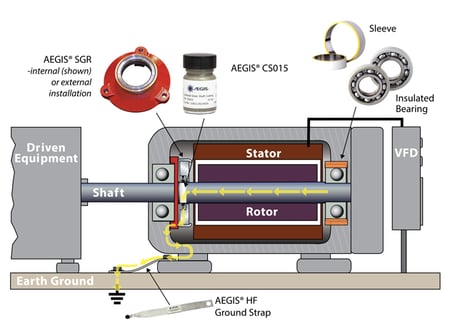Excellent article on the many things that must be looked out for when handling or installing bearings in electric motors. Published in the M+R (maintenance + Reliability) section of Maintenance Technology Magazine, the article lists nine different conditions or practices and gives great advice on each. Of course, each section is a topic in and of itself, and the one I would like to discuss in some more depth is:
Electric Current Arcing
Most pitting in a motor's bearings comes from one of 2 sources: (1) Capacitive coupled voltage from the stator to rotor through parasitic capacitance on all motors operated by a variable frequency drive (VFD)from small 1 HP to the largest medium voltage motors and (2) high frequency circulating currents which can occur on motors over 100 HP. Separate mitigation is necessary to protect the bearings from these two sources of bearing currents.
The phenomenon for the creation of electrical discharges is similar for both. Essentially, the voltage on the motor's shaft creates a potential high enough to overcome the dielectric of the oil film in the motor's bearings. When this happens an electrical arc shoots through from the inner race via the rolling element to the outer race, which is connected to the ground.
The energy in this arc is great enough to melt the hardened bearing steel and create an electrical discharge machining (EDM) pit in the bearing race. The steel surface melts, and the metal hardens on the rim of the EDM pit. Then, the rolling element can either deform the bearing race surface, break the metal particle, or contaminate the bearing. Last but not least, the lubrication burns and deteriorates.
This process can occur MILLIONS of times per hour, and after just a short while, the bearing surface is pitted, and a phenomenon known as "fluting" starts. This is a washboard-type pattern along the bearing race creating vibration, heat, and eventual bearing failure.
How do we stop this from happening?


First: Download the AEGIS Bearing Protection Handbook!
Low-Voltage Motors up to 100 HP: Install AEGIS® Shaft Grounding Rings for these motors, usually on the drive side, either internally or externally.
Motors over 100 HP: Install one AEGIS® Shaft Grounding Ring on the drive end AND insulated bearing on the non-drive end opposite the shaft grounding ring, which prevents circulating currents that may be present in addition to capacitive induced shaft voltage.


